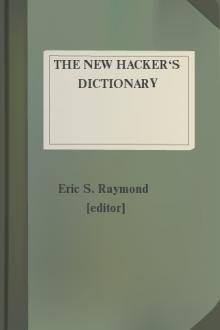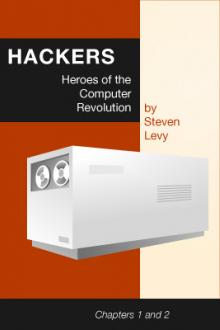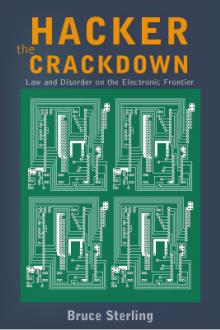The Jargon File by Eric S. Raymond (ebook reader android txt) 📕

- Author: Eric S. Raymond
- Performer: -
Book online «The Jargon File by Eric S. Raymond (ebook reader android txt) 📕». Author Eric S. Raymond
`tires out'. See also [1161]burn-in period, [1162]infant mortality.
Node:baud, Next:[1163]baud barf, Previous:[1164]bathtub curve,
Up:[1165]= B =
baud /bawd/ n.
[simplified from its technical meaning] n. Bits per second. Hence
kilobaud or Kbaud, thousands of bits per second. The technical meaning
is `level transitions per second'; this coincides with bps only for
two-level modulation with no framing or stop bits. Most hackers are
aware of these nuances but blithely ignore them.
Historical note: `baud' was originally a unit of telegraph signalling
speed, set at one pulse per second. It was proposed at the November,
1926 conference of the Comit� Consultatif International Des
Communications T�l�graphiques as an improvement on the then standard
practice of referring to line speeds in terms of words per minute, and
named for Jean Maurice Emile Baudot (1845-1903), a French engineer who
did a lot of pioneering work in early teleprinters.
Node:baud barf, Next:[1166]baz, Previous:[1167]baud, Up:[1168]= B =
baud barf /bawd barf/ n.
The garbage one gets a terminal (or terminal emulator) when using a
modem connection with some protocol setting (esp. line speed)
incorrect, or when someone picks up a voice extension on the same
line, or when really bad line noise disrupts the connection. Baud barf
is not completely [1169]random, by the way; hackers with a lot of
serial-line experience can usually tell whether the device at the
other end is expecting a higher or lower speed than the terminal is
set to. Really experienced ones can identify particular speeds.
Node:baz, Next:[1170]bazaar, Previous:[1171]baud barf, Up:[1172]= B =
baz /baz/ n.
[common] The third [1173]metasyntactic variable "Suppose we havethree functions: FOO, BAR, and BAZ. FOO calls BAR, which calls
BAZ...." (See also [1174]fum) 2. interj. A term of mild annoyance. In
this usage the term is often drawn out for 2 or 3 seconds, producing
an effect not unlike the bleating of a sheep; /baaaaaaz/. 3.
Occasionally appended to [1175]foo to produce `foobaz'.
Earlier versions of this lexicon derived `baz' as a Stanford
corruption of [1176]bar. However, Pete Samson (compiler of the
[1177]TMRC lexicon) reports it was already current when he joined TMRC
in 1958. He says "It came from "Pogo". Albert the Alligator, when
vexed or outraged, would shout Bazz Fazz!' orRowrbazzle!' The club
layout was said to model the (mythical) New England counties of
Rowrfolk and Bassex (Rowrbazzle mingled with
(Norfolk/Suffolk/Middlesex/Essex)."
Node:bazaar, Next:[1178]bboard, Previous:[1179]baz, Up:[1180]= B =
bazaar n.,adj.
In 1997, after meditatating on the success of [1181]Linux for three
years, the Jargon File's own editor ESR wrote an analytical paper on
hacker culture and development models titled [1182]The Cathedral and
the Bazaar. The main argument of the paper was that [1183]Brooks's Law
is not the whole story; given the right social machinery, debugging
can be efficiently parallelized across large numbers of programmers.
The title metaphor caught on (see also [1184]cathedral), and the style
of development typical in the Linux community is now often referred to
as the bazaar mode. Its characteristics include releasing code early
and often, and actively seeking the largest possible pool of peer
reviewers.
Node:bboard, Next:[1185]BBS, Previous:[1186]bazaar, Up:[1187]= B =
bboard /bee'bord/ n.
[contraction of `bulletin board'] 1. Any electronic bulletin board;
esp. used of [1188]BBS systems running on personal micros, less
frequently of a Usenet [1189]newsgroup (in fact, use of this term for
a newsgroup generally marks one either as a [1190]newbie fresh in from
the BBS world or as a real old-timer predating Usenet). 2. At CMU and
other colleges with similar facilities, refers to campus-wide
electronic bulletin boards. 3. The term `physical bboard' is sometimes
used to refer to an old-fashioned, non-electronic cork-and-thumbtack
memo board. At CMU, it refers to a particular one outside the CS
Lounge.
In either of senses 1 or 2, the term is usually prefixed by the name
of the intended board (the Moonlight Casino bboard' ormarket
bboard'); however, if the context is clear, the better-read bboards
may be referred to by name alone, as in (at CMU) "Don't post for-sale
ads on general".
Node:BBS, Next:[1191]BCPL, Previous:[1192]bboard, Up:[1193]= B =
BBS /B-B-S/ n.
[common; abbreviation, `Bulletin Board System'] An electronic bulletin
board system; that is, a message database where people can log in and
leave broadcast messages for others grouped (typically) into
[1194]topic groups. The term was especially applied to the thousands
of local BBS systems that operated during the pre-Internet
microcomputer era of roughly 1980 to 1995, typically run by amateurs
for fun out of their homes on MS-DOS boxes with a single modem line
each. Fans of Usenet and Internet or the big commercial timesharing
bboards such as CompuServe and GEnie tended to consider local BBSes
the low-rent district of the hacker culture, but they served a
valuable function by knitting together lots of hackers and users in
the personal-micro world who would otherwise have been unable to
exchange code at all. Post-Internet, BBSs are likely to be local
newsgroups on an ISP; efficiency has increased but a certain flavor
has been lost. See also [1195]bboard.
Node:BCPL, Next:[1196]beam, Previous:[1197]BBS, Up:[1198]= B =
BCPL // n.
[abbreviation, `Basic Combined Programming Language') A programming
language developed by Martin Richards in Cambridge in 1967. It is
remarkable for its rich syntax, small size of compiler (it can be run
in 16k) and extreme portability. It reached break-even point at a very
early stage, and was the language in which the original [1199]hello
world program was written. It has been ported to so many different
systems that its creator confesses to having lost count. It has only
one data type (a machine word) which can be used as an integer, a
character, a floating point number, a pointer, or almost anything
else, depending on context. BCPL was a precursor of C, which inherited
some of its features.
Node:beam, Next:[1200]beanie key, Previous:[1201]BCPL, Up:[1202]= B =
beam vt.
[from Star Trek Classic's "Beam me up, Scotty!"] 1. To transfer
[1203]softcopy of a file electronically; most often in combining forms
such as beam me a copy' orbeam that over to his site'. 2. Palm
Pilot users very commonly use this term for the act of exchanging bits
via the infrared links on their machines (this term seems to have
originated with the ill-fated Newton Message Pad). Compare
[1204]blast, [1205]snarf, [1206]BLT.
Node:beanie key, Next:[1207]beep, Previous:[1208]beam, Up:[1209]= B =
beanie key n.
[Mac users] See [1210]command key.
Node:beep, Next:[1211]Befunge, Previous:[1212]beanie key, Up:[1213]= B
=
beep n.,v.
Syn. [1214]feep. This term is techspeak under MS-DOS and OS/2, and
seems to be generally preferred among micro hobbyists.
Node:Befunge, Next:[1215]beige toaster, Previous:[1216]beep,
Up:[1217]= B =
Befunge n.
A worthy companion to [1218]INTERCAL; a computer language family which
escapes the quotidian limitation of linear control flow and embraces
program counters flying through multiple dimensions with exotic
topologies. Sadly, the Befunge home page has vanished, but a Befunge
version of the [1219]hello world program is at
[1220]http://www.catseye.mb.ca/esoteric/befunge.html.
Node:beige toaster, Next:[1221]bells and whistles,
Previous:[1222]Befunge, Up:[1223]= B =
beige toaster n.
A Macintosh. See [1224]toaster; compare [1225]Macintrash,
[1226]maggotbox.
Node:bells and whistles, Next:[1227]bells whistles and gongs,
Previous:[1228]beige toaster, Up:[1229]= B =
bells and whistles n.
[common] Features added to a program or system to make it more
[1230]flavorful from a hacker's point of view, without necessarily
adding to its utility for its primary function. Distinguished from
[1231]chrome, which is intended to attract users. "Now that we've got
the basic program working, let's go back and add some bells and
whistles." No one seems to know what distinguishes a bell from a
whistle. The recognized emphatic form is "bells, whistles, and gongs".
It used to be thought that this term derived from the toyboxes on
theater organs. However, the "and gongs" strongly suggests a different
origin, at sea. Before powered horns, ships routinely used bells,
whistles, and gongs to signal each other over longer distances than
voice can carry.
Node:bells whistles and gongs, Next:[1232]benchmark,
Previous:[1233]bells and whistles, Up:[1234]= B =
bells whistles and gongs n.
A standard elaborated form of [1235]bells and whistles; typically said
with a pronounced and ironic accent on the `gongs'.
Node:benchmark, Next:[1236]Berkeley Quality Software,
Previous:[1237]bells whistles and gongs, Up:[1238]= B =
benchmark n.
[techspeak] An inaccurate measure of computer performance. "In the
computer industry, there are three kinds of lies: lies, damn lies, and
benchmarks." Well-known ones include Whetstone, Dhrystone, Rhealstone
(see [1239]h), the Gabriel LISP benchmarks (see [1240]gabriel), the
SPECmark suite, and LINPACK. See also [1241]machoflops, [1242]MIPS,
[1243]smoke and mirrors.
Node:Berkeley Quality Software, Next:[1244]berklix,
Previous:[1245]benchmark, Up:[1246]= B =
Berkeley Quality Software adj.
(often abbreviated `BQS') Term used in a pejorative sense to refer to
software that was apparently created by rather spaced-out hackers late
at night to solve some unique problem. It usually has nonexistent,
incomplete, or incorrect documentation, has been tested on at least
two examples, and core dumps when anyone else attempts to use it. This
term was frequently applied to early versions of the dbx(1) debugger.
See also [1247]Berzerkeley.
Note to British and Commonwealth readers: that's /berk'lee/, not
/bark'lee/ as in British Received Pronunciation.
Node:berklix, Next:[1248]Berzerkeley, Previous:[1249]Berkeley Quality
Software, Up:[1250]= B =
berklix /berk'liks/ n.,adj.
[contraction of `Berkeley Unix'] See [1251]BSD. Not used at Berkeley
itself. May be more common among [1252]suits attempting to sound like
cognoscenti than among hackers, who usually just say `BSD'.
Node:Berzerkeley, Next:[1253]beta, Previous:[1254]berklix, Up:[1255]=
B =
Berzerkeley /b*r-zer'klee/ n.
[from `berserk', via the name of a now-deceased record label; poss.
originated by famed columnist Herb Caen] Humorous distortion of
`Berkeley' used esp. to refer to the practices or products of the
[1256]BSD Unix hackers. See [1257]software bloat,
[1258]Missed'em-five, [1259]Berkeley Quality Software.
Mainstream use of this term in reference to the cultural and political
peculiarities of UC Berkeley as a whole has been reported from as far
back as the 1960s.
Node:beta, Next:[1260]BFI, Previous:[1261]Berzerkeley, Up:[1262]= B =
beta /bay't/, /be't/ or (Commonwealth) /bee't*/ n.
Mostly working, but still under test; usu. used with in':inbeta'. In the [1263]Real World, systems (hardware or software)
software often go through two stages of release testing: Alpha
(in-house) and Beta (out-house?). Beta releases are generally made to
a group of lucky (or unlucky) trusted customers. 2. Anything that is
new and experimental. "His girlfriend is in beta" means that he is
still testing for compatibility and reserving judgment. 3. Flaky;
dubious; suspect (since beta software is notoriously buggy).
Historical note: More formally, to beta-test is to test a pre-release
(potentially unreliable) version of a piece of software by making it
available to selected (or self-selected) customers and users. This
term derives from early 1960s terminology for product cycle
checkpoints, first used at IBM but later standard throughout the
industry. `Alpha Test' was the unit, module, or component test phase;
`Beta Test' was initial system test. These themselves came from
earlier A- and B-tests for hardware. The A-test was a feasibility and
manufacturability evaluation done before any commitment to design and
development. The B-test was a demonstration that the engineering model
functioned as specified. The C-test (corresponding to today's beta)
was the B-test performed on early samples of the production design,
and the D test was the C test repeated after the model had been in
production a while.
Node:BFI, Next:[1264]bible, Previous:[1265]beta, Up:[1266]= B =
BFI /B-F-I/ n.
See [1267]brute force and ignorance. Also encountered in the variants
BFMI',brute force and massive ignorance' and BFBI'brute force
and bloody ignorance'. In dome parts of the U.S. this abbreviation was
probably reinforced by a company called Browning-Ferris Industries who
used to be in the waste-management business; a large BFI logo in
white-on-blue could be seen on the sides of garbage trucks.
Node:bible, Next:[1268]BiCapitalization, Previous:[1269]BFI,
Up:[1270]= B =
bible n.
One of a small number of fundamental source books such as[1271]Knuth, [1272]K&R, or the [1273]Camel Book. 2. The most detailed
and authoritative reference for a particular language, operating
system, or other complex software system.
Node:BiCapitalization, Next:[1274]B1FF, Previous:[1275]bible,
Up:[1276]= B =
BiCapitalization n.
The act said to have been





Comments (0)